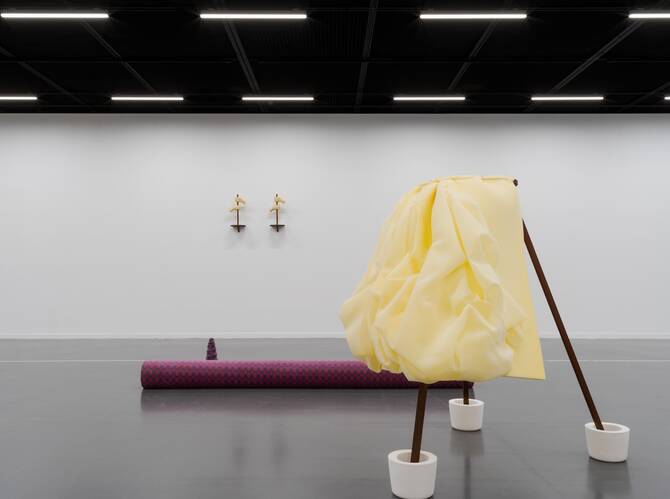
- ARAB NEWS
- 18 Aug 2025

DUBAI: The first large-scale showcase of contemporary Korean art in the Gulf Cooperation Council region, “Layered Medium: We Are in Open Circuits – Contemporary Art from Korea, 1960s to Today,” promises to be a transformative experience for audiences in the Middle East.
Co-curated by Maya El-Khalil of the Abu Dhabi Music & Arts Foundation and Yeo Kyung-hwan of the Seoul Museum of Art, the exhibition brings together a sweeping collection of artworks that explore the evolution of Korean contemporary art from its roots in the 1960s to the present day.
Held at the Abu Dhabi art gallery Manarat Al-Saadiyat from May 16 to June 30, the exhibition marks a historic cultural bridge between Korea and the region, offering insights into how Korean artists have responded to shifts in political landscapes, technological advancements, and the complexities of modernity.

“This exhibition is a testament to the power of art to transcend boundaries and ignite conversations across cultures,” said El-Khalil to Arab News. “It’s an opportunity for audiences to witness the dynamism and resilience of Korean art over decades of transformation.”
El-Khalil drew on her first experiences in Seoul, which she described as a “moment of discovery.” For her, the city revealed what she called “productive contradictions”: an art scene that was deeply specific to its context but spoke to universal experiences of urbanization, globalization, and technological change.
“This tension between specificity and universality became central to our curatorial approach. Rather than trying to explain Korean art, we wanted to create frameworks that would allow audiences to encounter works through shared experiences of inhabiting our rapidly shifting, technologically mediated worlds,” El-Khalil said.

The exhibition begins with the immediate sensory experiences of the body, intersecting with social constructs of gender, nationality, and identity. From there it connects to cultural narratives of history and tradition before engaging with contemporary spatial realities of rapid urbanisation and precarious ecologies. It begins with its experimental phases in the 1960s, moving through the politically charged works of the 1980s, and culminating in the boundary pushing digital and multimedia explorations of today.
Yeo explained the curatorial decision. “We experience reality through our bodies, our social structures, and our physical and virtual terrains. By organizing the exhibition through this expanded sense of medium — as atmospheres of meaning-making — we created a framework that reflects circuits of experience: from our immediate bodily presence to our social relationships, to our navigation of built environments striated with power and control.”

Among the standout works are installations that challenge conventional perceptions of space and time, multimedia projects that intertwine Korean folklore with digital storytelling, and large-scale sculptures that articulate the tension between tradition and innovation. El-Khalil spoke of parallels between Seoul and Abu Dhabi, citing rapid urbanization and globalization as shared narratives.
“Both cities are the product of rapid, accelerated development, each environment a remarkable narrative of transformation, though the stories are quite distinct: South Korea emerging after war and poverty, while the UAE grew quickly thanks to a clear vision and the discovery of natural resources,” she said.
“What’s really interesting is how artists in both places respond to similar changes like urbanisation or globalisation but from different cultural perspectives. Even though these changes seem global, they’re always shaped by local histories and ideas about the future. For example, Sung Hwan Kim’s ‘Temper Clay’ (2012), set in uniform apartment blocks, looks at the emotional and social impact of this kind of growth. These parallels allowed us to explore how different societies process similar transformations through different historical and cultural frameworks,” she added.

The exhibition also highlights the impact of technological revolutions on Korean art, particularly in the realm of video and digital installations that emerged in the late 1990s. “Korean artists have always been at the forefront of exploring new media, often using technology as a medium to dissect cultural narratives and global dialogues,” said Yeo. “Their work is a testament to adaptability and forward-thinking—an open circuit that is constantly evolving.”
In addition to the main exhibition, “Layered Medium” features a series of panel discussions, workshops, and interactive installations aimed at engaging the community in dialogue about the role of contemporary art in shaping cultural identity and understanding. El-Khalil emphasized the importance of these community-focused initiatives: “We want this exhibition to be more than just a visual experience; it’s a platform for learning and cross-cultural exchange.”
As the first large-scale Korean art exhibition in the GCC, “Layered Medium” is poised to set a new standard for artistic collaboration between Korea and the Middle East. With its emphasis on dialogue, innovation, and historical reflection, the exhibition not only showcases the richness of Korean artistic expression but also reinforces the universal language of art as a bridge across diverse cultures.
“Ultimately, our hope is that visitors leave with a deeper appreciation for the complexity and beauty of Korean contemporary art,” said Yeo. “It’s about creating connections—not just between East and West, but across generations, mediums, and ideologies.”